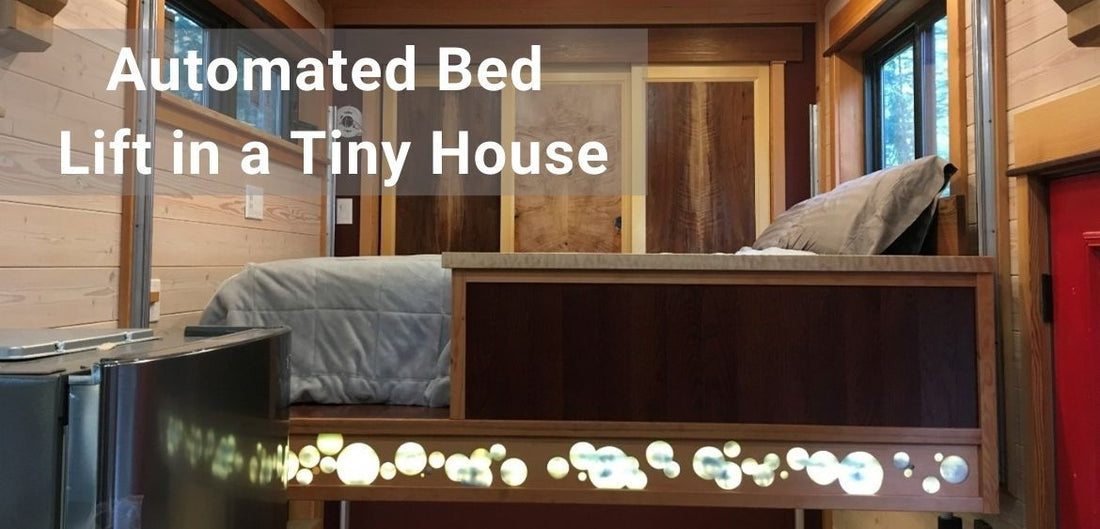At Progressive Automations, we love to receive feedback from clients who have used our linear actuators in innovative and interesting ways! One such project involved our customer, Sam, who built an automated bed with linear actuators to fit inside his tiny house build. Space and head room are always an issue in structures like this, so being able to raise the bed above head height was a great way to utilize the available space.
In this article, we walk you through exactly how to set up a linear actuator to move a bed, and the bed lift kit you will need to do it.
How to Choose a 12 VDC Linear Actuator for a Bed Lift
Choosing the best 24 VDC linear actuator for a bed lift mechanism comes with its challenges. When our client started his bed lift project, here are just some of the problems he encountered:
- Determining the weight capacity of the linear actuator.
- Cosmetic appeal of the wiring and mounted linear actuators.
- Weight distribution on the linear actuators.
- Bed dimension requirements (i.e., building a bed base that would fit between the two walls and leave enough space for mounting guide rails).
Due to space limitations, using an electric linear actuator from Progressive Automations was the best option for the bed lift mechanism since it did not require any large pieces of equipment, as is the case with hydraulic or pneumatic linear actuators. Before we get into the technicalities of the bed lift mechanism, how do you select the right linear actuator? The two main considerations are the force and stroke of a linear actuator. You will need a linear actuator that can handle the weight of the bed you intend on lifting. Four linear actuators will be used, which means the weight of the bed will be distributed among them (load per actuator = total weight of the bed / number of linear actuators).
What Was Used in This Project?
Sam chose the 24 VDC PA-04-HS linear actuator based on his bed weight requirements and since the actuator comes with an optional Hall effect sensor. The Hall effect sensors allow for the uneven weight distribution of the bed and ensures the actuators move in sync. The actuator movement is critical to keep the bed level throughout its full range of motion.
Alternatively, the PA-18 track actuator would also work so that the starting height of the bed would not be limited by the stroke length. It also comes in a much higher load capacity, ensuring the motor is more than capable of handling bigger beds.
How to Build Your Own Bed Lift Mechanism

An electric bed lift system can be created in several ways, depending on the available space. The bed could move out from a wall horizontally or, in the case with our client, raise the bed vertically to be able to walk underneath it. Bear in mind that this brief guide will vary depending on your bed dimensions, how far away your walls are from the bed, and several other factors. However, the general principle remains the same. Below is a list of items you will need to get started.
What You Will Need
- RT-11 Remote
- FLTCON-4 Control Box
- 4 x 24 VDC electric linear actuators (PA-04-HS was used in this project, but specifications may vary)
- Power supply (matched with the chosen linear actuator)
- Mounting brackets (BRK-01 were used in this project, as they pair with the PA-04)
- Guide rails
- Tools, cabling, etc.
The Steps
Once your bed is in place, measure and mount the guide rails. You may require several extra hands to help lift the bed up and down manually to double check that the bed moves smoothly without any hinderances, which would cause the linear actuator motors to stall. The guide rail should simply be just that…a guide. If the rails are too tight, it will eventually burn out your linear actuators due to excessive stalling of the motor.

With the bed raised and held in place by a jack or by your trusty helpers, mount the four linear actuators near each corner of the bed, taking into consideration the stroke as this will determine the travel of the bed. Additionally, the top of the linear actuator will need to be mounted on the wall for extra stability as shown in the image below. The mounting brackets make this part of the project fast and efficient.

All cablings are routed through the wall to the control box and power supply to ensure no wires tangle or get in the way when the bed is raised, and you could utilize the space underneath. Cabling that is in the way can be a trip hazard and cause serious injury. The height of the bed is controlled with a remote control mounted on the wall with cabling also routed through the wall. A bed actuator with a remote is the best way to control the stroke of an actuator. Moreover, the remotes from Progressive Automations allow for multiple pre-set positions to be saved.

Get Building!
Building a bed lift is a fun, and exciting project to take on. Your bed lift kit will last the distance by making sure you purchase quality linear actuators. Progressive Automations stock all the components you will need to complete this project (besides the bed of course). To see the electric bed lift system in action, view the video below! Since Sam installed this bed lift kit in a small space, he had the advantage of nearby walls that made for the easy mounting of the linear actuators. If your bed is not near a wall, you will have to figure out a way to mount the linear actuators vertically and provide enough support to avoid excessive strain.
For more information on how to wire up linear actuators to our control box and remote, visit our resources on our website. If you have built an application using our actuator products, we would love to know more so that we can share it with the DIY community. Give us a call or email us sales@progressiveautomations.com.




